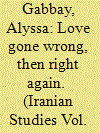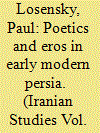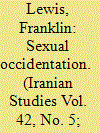|
|
|
Sort Order |
|
|
|
Items / Page
|
|
|
|
|
|
|
| Srl | Item |
| 1 |
ID:
092948


|
|
|
|
|
| Publication |
2009.
|
| Summary/Abstract |
The patronage system at the Mughal court drew many Safavid poets and men of learning to India who interacted with Indians at various levels. In an unusual case, the young Iranian poet 'Urf?'s attachment to his patron, Prince Sal?m (later Emperor Jah ng?r), was interpreted by some as more than merely professional and the poet's death at a young age gave rise to speculations of intrigue. Mughal princesses were also actively involved in the literary scene of the time. In another instance, the association of Princess Z?bunnisa, daughter of the Emperor Awrangz?b, with Persian poets was sometimes personal, leading to gossip and scandal about her. It turns out that in both cases stories about the sexual aspects of the relationships between Mughal patrons and Iranian poets arose in the eighteenth century and are more reflective of the concerns of the literary culture of that period. This paper explores the power and gender dynamics of these poet-patron relationships in the context of the general Iranian-Indian tension at the Mughal court and a highly developed and creative tradition of crafting biographical accounts.
|
|
|
|
|
|
|
|
|
|
|
|
|
|
|
|
| 2 |
ID:
092944


|
|
|
|
|
| Publication |
2009.
|
| Summary/Abstract |
This article examines male/female dynamics in three versions of the classical story of the Sassanian prince Bahr m G r and his lyre-playing slave girl: that of the Sh hn ma of Firdaws?, the Haft Paykar of Niz m? Ganjav?, and the Hasht Bihisht of Am?r Khusraw. It argues that each version provides progressively more positive depictions of intergender dynamics, ones that are contingent upon more egalitarian understandings of the male/female dichotomy. The later authors destabilize the categories of "male" and "female," equalizing and even uniting the dichotomous pairs, so that men and women draw nearer to each other in qualities rather than remaining in their usual polarized positions. In the Hasht Bihisht, moreover, we witness a reversal of hierarchies in which traditionally feminine qualities receive preference over masculine virtues-an act that suggests fresh possibilities for harmonious interactions between the sexes.
|
|
|
|
|
|
|
|
|
|
|
|
|
|
|
|
| 3 |
ID:
092947


|
|
|
|
|
| Publication |
2009.
|
| Summary/Abstract |
The poet Muhtasham K sh n? (d. 1588) is today known primarily for his strophic elegy on the martyrdom of Imam Husayn at Karbal , but such devotional poems make up only a tiny fraction of large oeuvre. Far more substantial are two works of a very different tenor, Nuql-i 'Ushsh q (The Lover's Confection) and Ris la-yi Jal liyya (The Glorious Epistle). Using an innovative combination of prose and poetry, these works tell the story of the poet-narrator's stormy affairs with, respectively, an upper-class courtesan and a footman attached to a nobleman's house. As part of the larger literary movement known as the maktab-i vuq ' or "realist school," these purported autobiographical accounts of Muhtasham's amorous adventures reveal a sophisticated culture of eros and desire that differs strikingly from the usual representations of the state of literature and the arts under Shah Tahm sp. After situating these works in their historical, literary, and cultural contexts, the article turns to a close analysis of an extended passage from each work to show how Muhtasham integrates lyric poetry, narrative, and setting to depict the pursuit of desire in the urbane world of early modern Persia
|
|
|
|
|
|
|
|
|
|
|
|
|
|
|
|
| 4 |
ID:
092945


|
|
|
|
|
| Publication |
2009.
|
| Summary/Abstract |
This article explores tales and tropes of conversion, especially conversion engendered by romantic attraction for the religious other, in the poetry of Far?d al-D?n 'Att r. The plot dynamics of class, gender and confessional adherence are complex, and hold important clues to the poet's theology. One particularly rich example of the encoding of religious and social boundaries can be found in a body of ghazals written about the beautiful Christian boy (tars -bachcha). The history of this homoerotic sub-genre is traced, and 'Att r's treatment of the theme is explored in juxtaposition not only to earlier authors, but to other motifs of the religious other and of religious conversion, appearing in his own oeuvre, including the narrative of Shaykh San' n with its representation of the Christian girl beloved. The terminology of Christianity and the markers by which 'Att r construes Christian-ness are discussed, and these symbolically amorous encounters with Christianity are analyzed as part of a larger discourse of emasculation which 'Att r constructs around conversion, religious affiliation, and insufficient commitment to spiritual growth. Analysis of the dynamic interplay of markers of gender and class in the tales and topoi dealing with religious conversion or cross-confessional interaction will ultimately afford a perspective into 'Att r's conception of the specific religious traditions juxtaposed to Islam, as well as his beliefs about inter-religious relations.
|
|
|
|
|
|
|
|
|
|
|
|
|
|
|
|
| 5 |
ID:
092946


|
|
|
|
|
| Publication |
2009.
|
| Summary/Abstract |
This article discusses the representation of Turks in the kulliy t (collected works) of the fourteenth-century poet 'Ubayd-i Z k n? (d. 1371). 'Ubayd is well known for his satirical works (e.g. M sh u gurba, Akhl q al-ashr f), but his courtly poetry (in particular his ghazals and qas?das) have yet to receive substantial scholarly attention. This study examines the various ways in which 'Ubayd presents Turks in his kulliy t, whether as an object of erotic desire, a figure to be feared on account of his violent nature, or else as a metaphor for the royal patron or other member of the ruling elite of fourteenth-century Shiraz. This article explores the tension that exists in 'Ubayd's works between these various depictions of the Turk, shows how references to Turks in bawdy prose works and other poetic genres (such as rub '?) can be used to interpret those found in more chaste ghazals, and discusses the possible implications the depiction of the Turk found in 'Ubayd's kulliy t may have for our understanding of references to Turks in the poetry of his contemporaries, in particular H fiz (d. 1389).
|
|
|
|
|
|
|
|
|
|
|
|
|
|
|
|
|
|
|
|
|